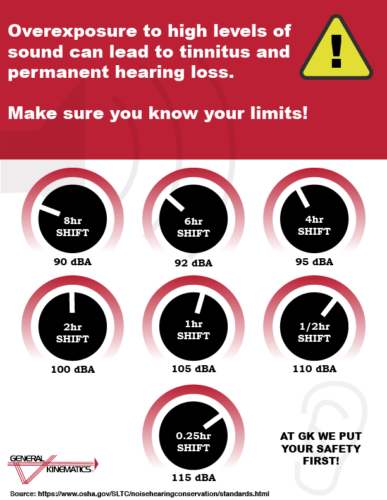Controlling sound levels in a foundry environment is an ongoing challenge. The processing of heavy industrial noise-transmitting material such as iron can contribute a lot of noise pollution to the surrounding area, which can cause long-term health problems for the employees working in these environments.
According to the Occupational Safety and Health Administration (OSHA), hearing loss has affected over 22 million people in the United States, with industrial exposure being the leading cause at 20%. Out of industrial exposure, the rate of hearing loss caused by foundry environments is roughly three times greater than in private manufacturing. Long-term exposure to high noise levels without protection can lead to tinnitus and permanent hearing loss, making it difficult to communicate and hear important safety signals.
What Causes Noise in a Foundry Environment?
In a foundry environment, many factors contribute to the creation of noise. Noise is rated as A-weighted decibels or dBA as perceived by the human ear. To list a few:
-Shakeouts (Vibratory or Rotary) (105-115 dBA)
-Shot Blast (100-110 dBA)
-Casting and sprue handling via conveyors and feeders (95-115 dBA)
-Cast Grinding (92-115 dBA)
Metal is a highly effective noise transmitter, so it should come as no surprise that moving and transporting this material will create excess noise. It is important to remember these factors when working in a foundry environment.
Permissible Exposure Limit
The permissible exposure limit (PEL) regulated by the United States Department of Labor depends on the hours of noise exposure. For example, if working an 8-hour shift, the PEL for that time is 90 dBA. The dBA PEL continues to increase as the time spent exposed to noise decreases gradually. Refer to the chart below for details on different lengths and exposure limits.
Per 1910.95(c)(1), if the action level of 85 dBA is met or exceeded, employees must participate in the Hearing Conservation Program, which requires noise monitoring, audiometric testing, hearing protection devices, employee testing, and documentation.
Ways to Prevent Exposure
Personal Protective Equipment, or PPE, may seem like a decent solution to noise exposure; however, according to NIOSH, PPE is less effective than reducing noise or engineering controls. The most common reasons cited were that the PPE was uncomfortable, ill-fitting, or neglected entirely. Many claim that PPE interferes with the ability to hear communications from coworkers; however, it has been proven that vocal interpretation actually increases in loud environments when PPE is used.
Administrative controls are a more practical option, as they include completely relocating employees away from harmful noises or reducing their exposure by shortening their shift. However, this option is not always beneficial to production, leading many to resort to another effective option: engineering controls.
GK Engineering Controls
If these noise limits are not met, your company can be cited for violations and fined. However, there are ways to suppress noise, and General Kinematics can help.
Here are a few things we recommend to our customers to reduce foundry noise levels:
- Enclosures can help isolate noise from operators. A popular option is hooded vibratory equipment and sound enclosures built directly around the equipment.
- Manipulators will remove operators from the source and let them work in an isolated cab.
- Liners provide iron handling equipment with sound-deadening troughs to dampen some of the projected noise. The materials available for this solution are sound-deadening sandwiched decks, aluminum liners, and external spray-on sound absorbers. Rubber can be implemented if the castings are below 200°F.
- Keeping your equipment operating correctly and within the correct stroke range reduces mechanical noise. Moving equipment further away from walls can also be helpful because it reduces the deflection of sound waves.
- Last but not least, GK Flat-Stroke-designed equipment eliminates the sound caused by large material impacts and keeps the castings in contact with the conveyor surface.
Do you want to learn more about reducing noise levels in your foundry? Contact me for more information!
Keep Reading:
Foundry Safety Part 2: Dust Control







